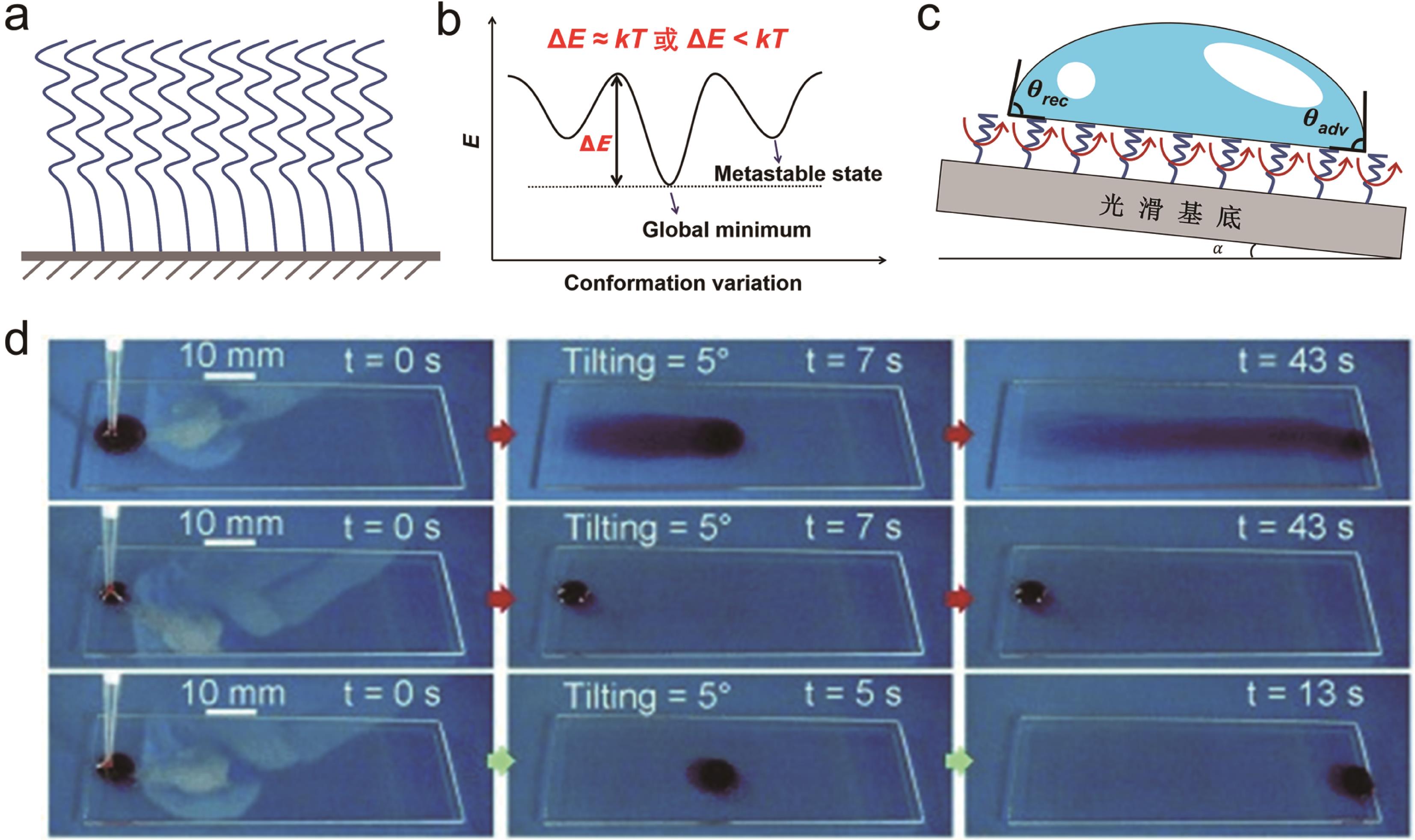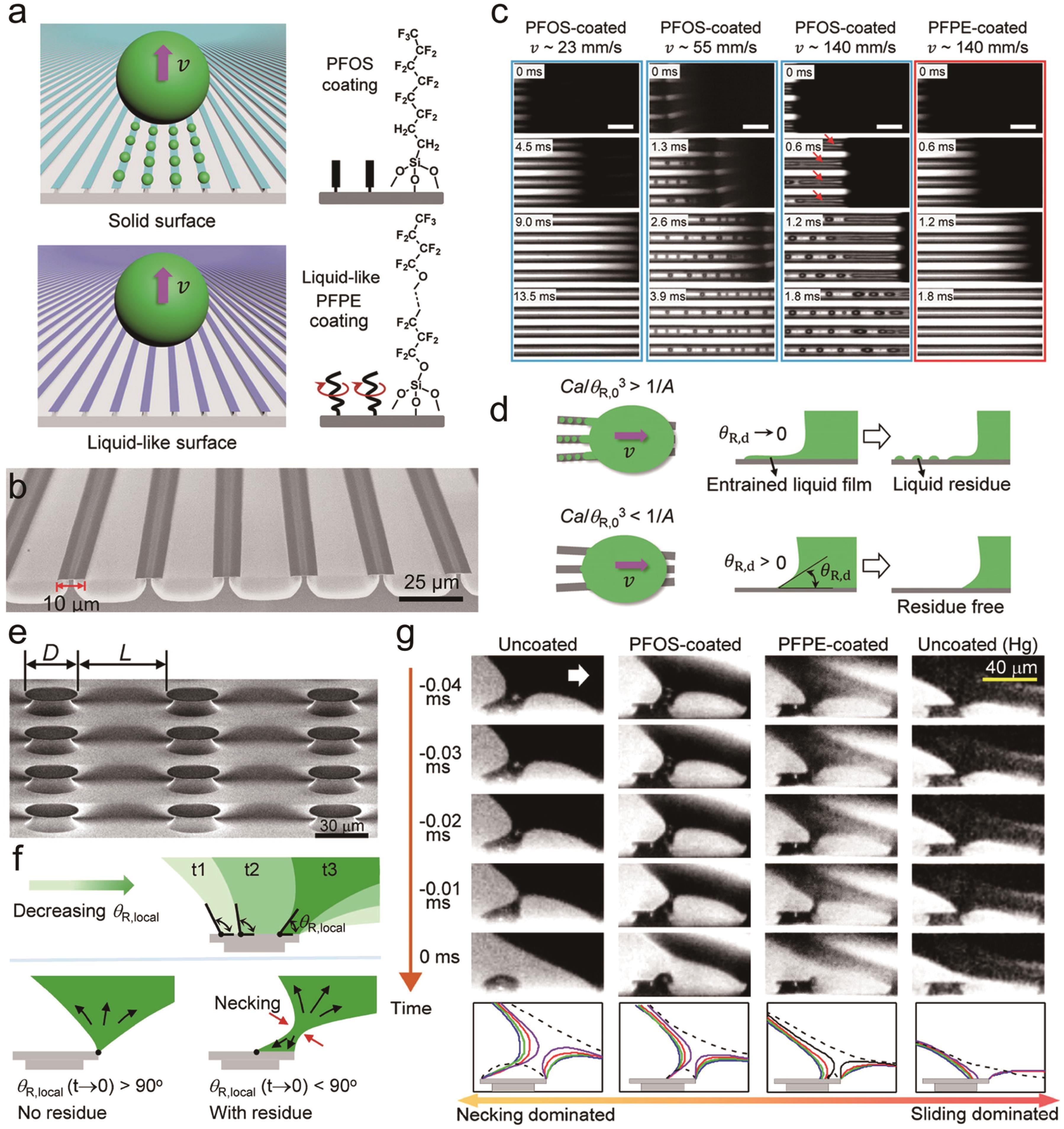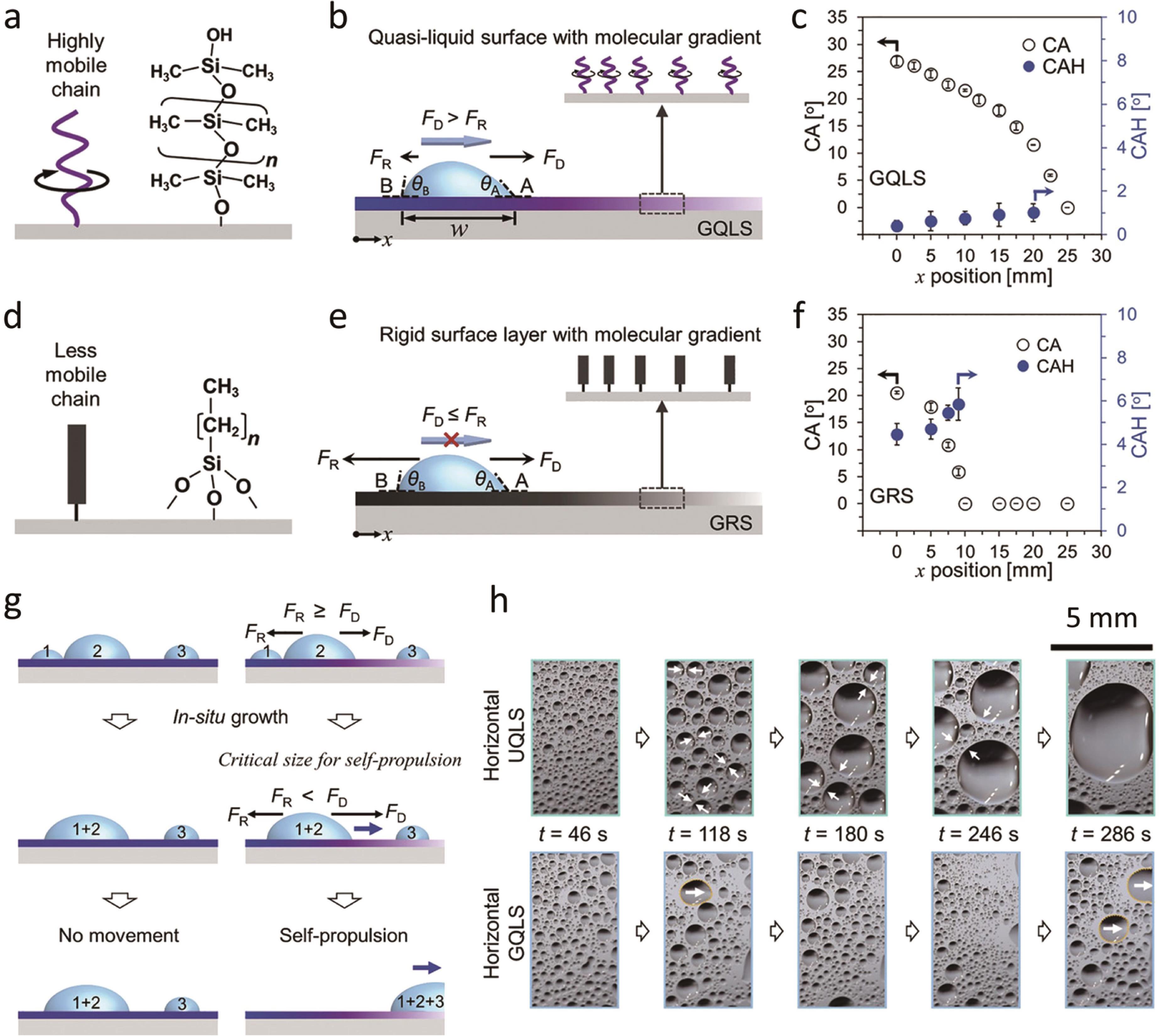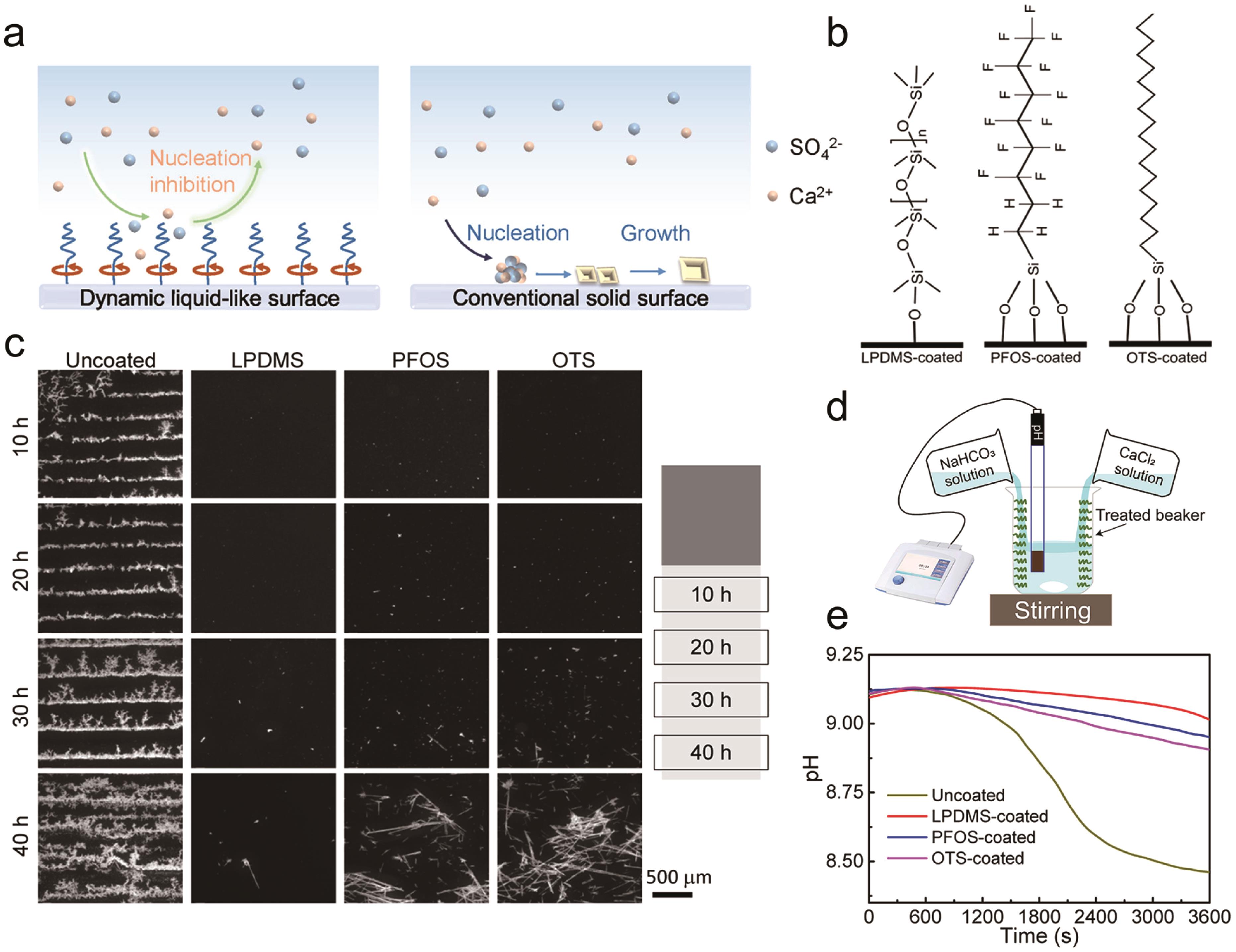
应用化学 ›› 2022, Vol. 39 ›› Issue (1): 131-141.DOI: 10.19894/j.issn.1000-0518.210490
类液体动态界面材料:近期应用进展
- 中山大学材料科学与工程学院,广州 510006
-
收稿日期:2021-10-03接受日期:2021-11-05出版日期:2022-01-01发布日期:2022-01-10 -
通讯作者:田雪林 -
基金资助:国家自然科学基金(21872176);广东省珠江人才计划(2017GC010671)
Liquid⁃like Dynamic Interfacial Materials: Recent Progress on Their Applications
- School of Materials Science and Engineering,Sun Yat-sen University,Guangzhou 510006,China
-
Received:2021-10-03Accepted:2021-11-05Published:2022-01-01Online:2022-01-10 -
Contact:Xue-Lin TIAN -
About author:tianxuelin@mail.sysu.edu.cn
-
Supported by:the National Natural Science Foundation of China(21872176);the Pearl River Talents Program(2017GC010671)
摘要:
类液体表面是接枝了高度柔性分子刷从而表现出类液体特性的表面。典型的类液体表面一般通过在平坦固体表面上共价接枝具有极低玻璃化转变温度的聚合物分子刷(其玻璃化转变温度一般在零下100 ℃以下)制备而成。由于所接枝分子链具有类似流体的高度动态特性,能自由旋转与运动,各种极性或非极性液体在这类被称为“类液体”或“准液体”的表面上粘附力低,易滑落,表现出极低的接触角滞后。传统上,对这类表面的研究主要限于简单的疏水及疏油应用。最近几年,国内外课题组相继报道了关于类液体表面的一些非常独特的界面物理化学特性;对其功能和应用的研究,也从简单的疏水、疏油,拓展到微观无损输运、防垢、除冰、冷凝传热和高性能膜分离等领域。基于类液体表面功能化的类液体动态界面材料也因而成为一类具有广阔应用前景的新兴材料体系。本文将在介绍类液体表面概念的基础上,重点介绍类液体动态界面材料最新的功能和应用研究成果,并对其未来研究和应用空间进行展望。
中图分类号:
引用本文
范岳, 田雪林. 类液体动态界面材料:近期应用进展[J]. 应用化学, 2022, 39(1): 131-141.
FAN Yue, TIAN Xue-Lin . Liquid⁃like Dynamic Interfacial Materials: Recent Progress on Their Applications[J]. Chinese Journal of Applied Chemistry, 2022, 39(1): 131-141.

图1 类液体表面的概念[19]a.柔性高分子刷接枝固体表面; b.化学键构象转变能垒; c.液滴在类液体表面滑动示意图; d.油红O染色甲苯液滴(20 μL)在干净玻璃片、氟硅烷修饰玻璃片以及类液体线性PDMS修饰玻璃片(依次从上至下)上滑动的时间变化图
Fig.1 The concept of liquid-like surfaces[19]a.Schematic of flexible polymer brush grafted on a solid surface. b.Energy barrier for conformational transition of chemical bonds. c.Side-view schematic of a droplet sliding on a liquid-like surface with a receding angle (θrec) slightly larger than its advancing angle (θadv). d.Time-sequence images show toluene droplets (20 μL, dyed with Oil red) sliding on a pristine glass slide, a glass slide with perfluoroalkylsilane coating and a glass with liquid-like linear PDMS coating (from top to bottom)

图2 类液体动态界面材料应用于抗液滴微观残留[26-27]a.类液体表面功能化连续轨道结构用于微观无损液滴输运示意图; b.单内凹结构微轨道阵列结构SEM图; c.类液体修饰的微轨道阵列与普通氟化修饰的微轨道阵列上液滴输运对比图; d.连续轨道上液体微残留形成机理; e.微柱阵列结构超疏表面SEM图; f.微柱上微毛细管桥颈缩与夹断效果示意图; g.微柱阵列不同条件下微残留形成对比图,从左至右依次为未修饰微柱、PFOS修饰微柱、PFPE修饰微柱上离子液体脱离过程,及未修饰微柱上汞液滴脱离过程
Fig.2 Liquid-like dynamic interface materials for elimination of microscopic liquid residue[26-27]a.Lossless drop transport on the array of microstripes with liquid-like PFPE coating. b.SEM images showing the surface morphology of arrayed microstripes. c.In situ observation of formation process of liquid residue on parallel microstripes coated with PFOS (three left panels) and PFPE (the rightmost panel). The scale bars are 40 μm. Nonvolatile IL1 is used as the probe liquid. d.Formation mechanisms of microscopic liquid residue. e.SEM images showing the surface morphology of arrayed micropillars. f.Schematic showing the evolution process of microcapillary bridges. g.Fast evolution dynamics of the microcapillary bridges just before pinch-off. Profiles of the liquid-air interfaces at -0.04 ms (solid blue lines), -0.03 ms (green lines), -0.02 ms (red lines), -0.01 ms (purple lines), and 0 ms (dash black lines) are given below the microscopic images. The columns in this image from left to right represent ionic liquid on uncoated micropillars, ionic liquid on PFOS-coated micropillars, ionic liquid on PFPE-coated micropillars and mercury on uncoated micropillars, respectively

图3 化学梯度类液体表面操控液滴自驱离运动以及对冷凝传热增强效应[28]a.聚二甲基硅氧烷柔性分子链示意图; b.化学梯度类液体表面效果示意图; c.化学梯度类液体表面接触角与接触角滞后随x轴变化图; d.刚性氟硅烷分子链示意图; e.化学梯度普通氟化表面效果示意图; f.化学梯度普通氟化表面接触角与接触角滞后随x轴变化图; g.普通类液体表面与化学梯度类液体表面冷凝效果对比图; h.普通类液体表面与化学梯度类液体表面上FC40液滴模拟冷凝时间变化对比图
Fig.3 Self-propulsion of liquids on the chemically gradient quasi-liquid surface (GQLS) and its effect on enhancement of condensation heat transfer[28]a.Tethered polydimethylsiloxane molecule on the surface with high molecular mobility. b.Side-view schematic of droplet motion on GQLS. c.Variation of contact angle (CA) and contact angle hysteresis (CAH) of along the surface of GQLS. d.The rigid coating of alkylsilane with low molecular mobility. e.Side-view schematic of the gradient rigid surface (GRS) which is formed by vapor diffusion grafting of octyltrichlorosilane. f.Variation of CA and CAH along the GRS in the x-direction. g.Schematic showing in situ droplet growth, merging and transport behaviors on uniform quasi-liquid surface (UQLS) and GQLS, respectively. h.Time-sequence images compare droplet condensation behaviors on UQLS and GQLS. Droplets of smaller critical size can move away from GQLS by self-propulsion, which prevents the formation of big droplets. The scale bar is 5 mm and the probe liquid is FC40

图4 类液体聚二甲基硅氧烷(LPDMS)涂层应用于表面防垢[29]a.类液体动态涂层表面防垢原理示意图; b.类液体聚二甲基硅氧烷(LPDMS)涂层及其全氟辛基三氯硅烷(PFOS),十八烷基三氯硅烷(OTS)对比涂层分子结构式; c.不同表面的CaSO4结垢过程(10、20、30、40 h); d.杯壁CaCO3结垢测试; e.经LPDMS及其对比涂层修饰的杯壁在CaCO3结垢测试中pH变化图
Fig.4 Liquid-like linear polydimethylsiloxane (LPDMS) brush coating for anti-scaling applications[29]a.Schematic diagram showing superior anti-scaling capability of dynamic liquid-like surfaces. b.Schematic illustration of the LPDMS-, PFOS-, and OTS-coated surfaces. c.Optical images showing time-dependent scaling behaviors of different samples after 10, 20, 30 and 40 h of solution evaporation. d.Schematic diagram of the experimental setup for CaCO3 scaling tests. e.Time-dependent pH change against different coatings

图5 增厚类液体聚二甲基硅氧烷(LPDMS)涂层应用于抗冰粘附及除冰[31]a.羟基化基底上进行类液体聚二甲基硅氧烷(LPDMS)涂层的一步法自催化接枝制备; b.液滴在类液体表面滑动及分子链由键旋转和弯曲带来高移动性的示意图; c.105度加热下水滴在类液体涂层上接触角滞后与时间关系图(插图展示了类液体涂层的稳定效果,3个月放置后5 μL液滴仍能在表面上滑走); d.冰在30.1 nm厚度类液体LPDMS(QLS)表面、5.0 nm厚度类液体LPDMS(SOCAL)表面、交联PDMS表面及普通玻璃表面剪切强度对比(插图为测试方法示意图); e.10次10.2 kg负载磨损循环后,冰在QLS表面与SOCAL表面最大剪切力对比(插图为测试装置示意图); f.10次10.2 kg负载磨损循环后,4.6 kPa的稳定风压对冰在QLS表面与SOCAL表面驱离效果
Fig.5 Quasi-liquid LPDMS polymer coating with increased thickness for reducing ice adhesion and passive removal of ice[31]a.One-step self-catalyzed grafting of LPDMS on a hydroxylated substrate. b.Schematic of droplet sliding on a tilted Quasi-liquid surface (QLS), where the mobile chain maintains its high mobility through rotational and/or bending motions of the Si-O-Si skeleton. c.Water contact angle hysteresis (CAH) as a function of heating time at 105 °C on the QLS with a silicon substrate. The insets show the stable effect of the QLS since a 5 μL water droplet can still slide on the QLS after more than 3 months. d.Shear strength of ice on the quasi-liquid coating with 30.1 nm thickness (QLS), quasi-liquid coating with 5.0 nm thickness (SOCAL), cross-linked PDMS, and bare glass surface. The inset shows the schematic diagram for the tests. e.Comparison of the maximal shear force of ice on the abraded QLS and SOCAL, which are abraded after 10 cycles with a load of 10.2 kg. The inset shows the test setup. f.The detachment of ice on the abraded QLS and the abraded SOCAL under the influence of wind with 4.6 kPa pressure.

图6 类液体聚二甲基硅氧烷(LPDMS)功能化膜应用于高粘度油水体系分离[33]a.聚二甲基硅氧烷(LPDMS)接枝不锈钢网表面形成类液体膜(LPDMS-SSM)以及其增强高粘度有机液体渗透通量的机理;b.原油/水混合物的分离性能测试的示意图以及实验装置; c.原油/水混合物的分离实验中,不同膜过滤原油的重量随时间变化图; d.原油/水混合物的分离实验中8分钟内的原油平均通量及第8分钟时原油终点通量; e - g.粘度为132.9 mPa·s、30.9 mPa·s以及25.6 mPa·s的原油(从上至下)在膜穿透分离实验中10分钟内的原油平均通量及第10分钟时原油终点通量
Fig.6 Liquid-like LPDMS functionalized membrane for separation of highly viscous oil/water system[33]a.Preparation of liquid-like stainless steel meshes membranes (LPDMS-SSM) by covalently grafting highly flexible liquid-like LPDMS polymer brushes and the schematic of its fast permeation towards highly viscous oils. b.Schematic and experimental set-up of crude oil-water separation test. c.Real-time monitoring the weight variation of separated crude oil as a function of time for different membranes. d.Average oil fluxes within 8 min and terminal oil fluxes at the 8th min in the separation. e - g.Plots of time-weight for oil permeation test, average permeate fluxes within 10 min, and terminal permeate fluxes at the 10th minute for viscosities of crude oils at 132.9 mPa·s, 30.9 mPa·s, and 25.6 mPa·s (from top to bottom)
| 1 | LIU M J, WANG S T, JIANG L. Nature-inspired superwettability systems[J]. Nat Rev Mater, 2017, 2(7): 1-17. |
| 2 | FENG L, LI S H, LI Y S, et al. Super-hydrophobic surfaces: from natural to artificial[J]. Adv Mater, 2002, 14(24): 1857-1860. |
| 3 | WONG T S, KANG S H, TANG S K Y, et al. Bioinspired self-repairing slippery surfaces with pressure-stable omniphobicity[J]. Nature, 2011, 477(7365): 443-447. |
| 4 | PARKER A R, LAWRENCE C R. Water capture by a desert beetle[J]. Nature, 2001, 414(6859): 33-34. |
| 5 | ZHENG Y M, BAI H, HUANG Z B, et al. Directional water collection on wetted spider silk[J]. Nature, 2010, 463(7281): 640-643. |
| 6 | JU J, BAI H, ZHENG Y M, et al. A multi-structural and multi-functional integrated fog collection system in cactus[J]. Nat Commun, 2012, 3(1): 1-6. |
| 7 | GAO X F, JIANG L. Water-repellent legs of water striders[J]. Nature, 2004, 432(7013): 36-36. |
| 8 | ZHENG Y M, GAO X F, JIANG L. Directional adhesion of superhydrophobic butterfly wings[J]. Soft Matter, 2007, 3(2): 178-182. |
| 9 | TIAN Y, SU B, JIANG L. Interfacial material system exhibiting superwettability[J]. Adv Mater, 2014, 26(40): 6872-6897. |
| 10 | WEN L P, TIAN Y, JIANG L. Bioinspired super-wettability from fundamental research to practical applications[J]. Angew Chem Int Ed, 2015, 54(11): 3387-3399. |
| 11 | SU B, TIAN Y, JIANG L. Bioinspired interfaces with superwettability: from materials to chemistry[J]. J Am Chem Soc, 2016, 138(6): 1727-1748. |
| 12 | LAI Y K, TANG Y X, GONG J P, et al. Transparent superhydrophobic/superhydrophilic TiO2-based coatings for self-cleaning and anti-fogging[J]. J Mater Chem, 2012, 22(15): 7420-7426. |
| 13 | CAO L L, JONES A K, SIKKA V K, et al. Anti-icing superhydrophobic coatings[J]. Langmuir, 2009, 25(21): 12444-12448. |
| 14 | ZHANG P, LV F Y. A review of the recent advances in superhydrophobic surfaces and the emerging energy-related applications[J]. Energy, 2015, 82: 1068-1087. |
| 15 | KIM P, WONG T S, ALVARENGA J, et al. Liquid-infused nanostructured surfaces with extreme anti-ice and anti-frost performance[J]. ACS Nano, 2012, 6(8): 6569-6577. |
| 16 | BOCQUET L, LAUGA E. A smooth future?[J] Nat Mater, 2011, 10(5): 334-337. |
| 17 | POETES R, HOLTZMANN K, FRANZE K, et al. Metastable underwater superhydrophobicity[J]. Phys Rev Lett, 2010, 105(16): 166104. |
| 18 | CAO M Y, GUO D W, YU C M, et al. Water-repellent properties of superhydrophobic and lubricant-infused “slippery” surfaces: a brief study on the functions and applications[J]. ACS Appl Mater Interfaces, 2016, 8(6): 3615-3623. |
| 19 | WANG L M, MCCARTHY T J. Covalently attached liquids: instant omniphobic surfaces with unprecedented repellency[J]. Angew Chem Int Ed, 2016, 55(1): 244-248. |
| 20 | SINGH N, KAKIUCHIDA H, SATO T, et al. Omniphobic metal surfaces with low contact angle hysteresis and tilt angles[J]. Langmuir, 2018, 34(38): 11405-11413. |
| 21 | CHENG D F, URATA C, YAGIHASHI M, et al. A statically oleophilic but dynamically oleophobic smooth nonperfluorinated surface[J]. Angew Chem, 2012, 124(12): 3010-3013. |
| 22 | CHEN W, FADEEV A Y, HSIEH M C, et al. Ultrahydrophobic and ultralyophobic surfaces: some comments and examples[J]. Langmuir, 1999, 15(10): 3395-3399. |
| 23 | HOZUMI A, MCCARTHY T J. Ultralyophobic oxidized aluminum surfaces exhibiting negligible contact angle hysteresis[J]. Langmuir, 2010, 26(4): 2567-2573. |
| 24 | LIU P, ZHANG H D, HE W Q, et al. Development of “liquid-like” copolymer nanocoatings for reactive oil-repellent surface[J]. ACS Nano, 2017, 11(2): 2248-2256. |
| 25 | RABNAWAZ M, LIU G J. Graft-copolymer-based approach to clear, durable, and anti-smudge polyurethane coatings[J]. Angew Chem Int Ed, 2015, 54(22): 6516-6520. |
| 26 | HUANG S L, LI J, LIU L, et al. Lossless fast drop self-transport on anisotropic omniphobic surfaces: origin and elimination of microscopic liquid residue[J]. Adv Mater, 2019, 31(27): 1901417. |
| 27 | HUANG S L, LI J, CHEN L W, et al. Suppressing the universal occurrence of microscopic liquid residues on super-liquid-repellent surfaces[J]. J Phys Chem Lett, 2021, 12(14): 3577-3585. |
| 28 | ZHANG L, GUO Z Q, SARMA J, et al. Gradient quasi‐liquid surface enabled self-propulsion of highly wetting liquids[J]. Adv Funct Mater, 2021, 31(13): 2008614. |
| 29 | CHEN Y X, YU X D, CHEN L W, et al. Dynamic poly(dimethylsiloxane) brush coating shows even better antiscaling capability than the low-surface-energy fluorocarbon counterpart[J]. Environ Sci Technol, 2021, 55(13): 8839-8847. |
| 30 | HUANG Y X, LIANG D Q, LUO C H, et al. Liquid-like surface modification for effective anti-scaling membrane distillation with uncompromised flux[J]. J Membr Sci, 2021, 637: 119673. |
| 31 | ZHANG L, GUO Z Q, SARMA J, et al. Passive removal of highly wetting liquids and ice on quasi-liquid surfaces[J]. ACS Appl Mater Interfaces, 2020, 12(17): 20084-20095. |
| 32 | ZHAO X X, KHATIR B, MIRSHAHIDI K, et al. Macroscopic evidence of the liquidlike nature of nanoscale polydimethylsiloxane brushes[J]. ACS Nano, 2021, 15(8): 13559-13567. |
| 33 | CHEN L W, FENG Q X, HUANG S L, et al. A grafted-liquid lubrication strategy to enhance membrane permeability in viscous liquid separation[J]. J Membr Sci, 2020, 610: 118240. |
| 34 | CHEN H W, ZHANG P F, ZHANG L W, et al. Continuous directional water transport on the peristome surface of Nepenthes alata[J]. Nature, 2016, 532(7597): 85-89. |
| 35 | HU H B, YU S X, SONG D. No-loss transportation of water droplets by patterning a desired hydrophobic path on a superhydrophobic surface[J]. Langmuir, 2016, 32(29): 7339-7345. |
| 36 | SNOEIJER J H, PITEIRA N L G, LIMAT L, et al. Cornered drops and rivulets[J]. Phys Fluids, 2007, 19(4): 042104. |
| 37 | PODGORSKI T, FLESSELLES J M, LIMAT L. Corners, cusps, and pearls in running drops[J]. Phys Rev Lett, 2001, 87(3): 036102. |
| 38 | MA J C, SETT S, CHA H, et al. Recent developments, challenges, and pathways to stable dropwise condensation: a perspective[J]. Appl Phys Lett, 2020, 116(26): 260501. |
| 39 | MENG J X, WANG S T. Advanced antiscaling interfacial materials toward highly efficient heat energy transfer[J]. Adv Funct Mater, 2020, 30(8): 1904796. |
| 40 | KREDER M J, ALVARENGA J, KIM P, et al. Design of anti-icing surfaces: smooth, textured or slippery?[J] Nat Rev Mater, 2016, 1(1): 1-15. |
| 41 | LIANG B, HE X, HOU J J, et al. Membrane separation in organic liquid: technologies, achievements, and opportunities[J]. Adv Mater, 2019, 31(45): 1806090. |
| 42 | HÉNOT M, DROCKENMULLER É, LÉGER L, et al. Friction of polymers: from PDMS melts to PDMS elastomers[J]. ACS Macro Lett, 2018, 7(1): 112-115. |
| [1] | 张晋红, 石奎, 徐鹏, 李倩, 薛龙建. 仿生表面液固界面摩擦力的动态调控[J]. 应用化学, 2022, 39(1): 188-195. |
| [2] | 石彦龙, 冯晓娟. 超疏水性生物表面的研究进展[J]. 应用化学, 2012, 29(05): 489-497. |
| [3] | 石彦龙, 冯晓娟, 杨武, 王永生. 硅烷表面修饰引发的ZnO微米棒膜的超疏水性[J]. 应用化学, 2011, 28(04): 402-407. |
| 阅读次数 | ||||||
|
全文 |
|
|||||
|
摘要 |
|
|||||
